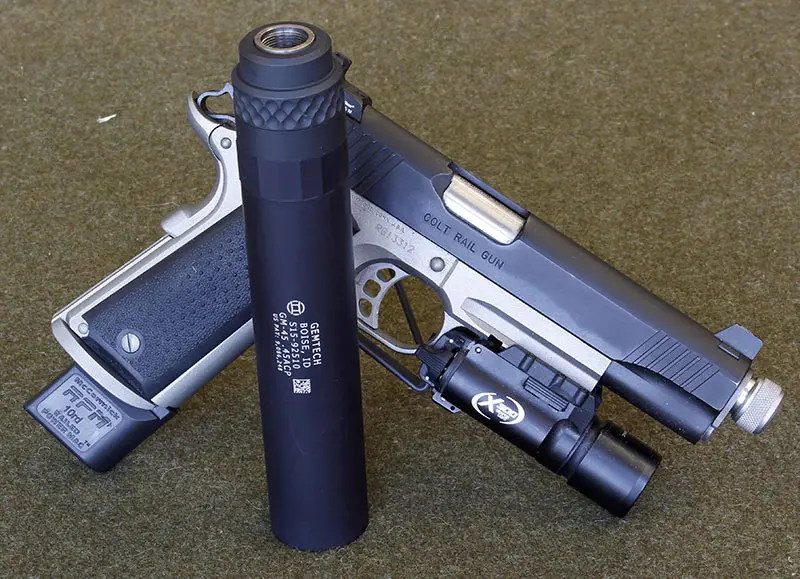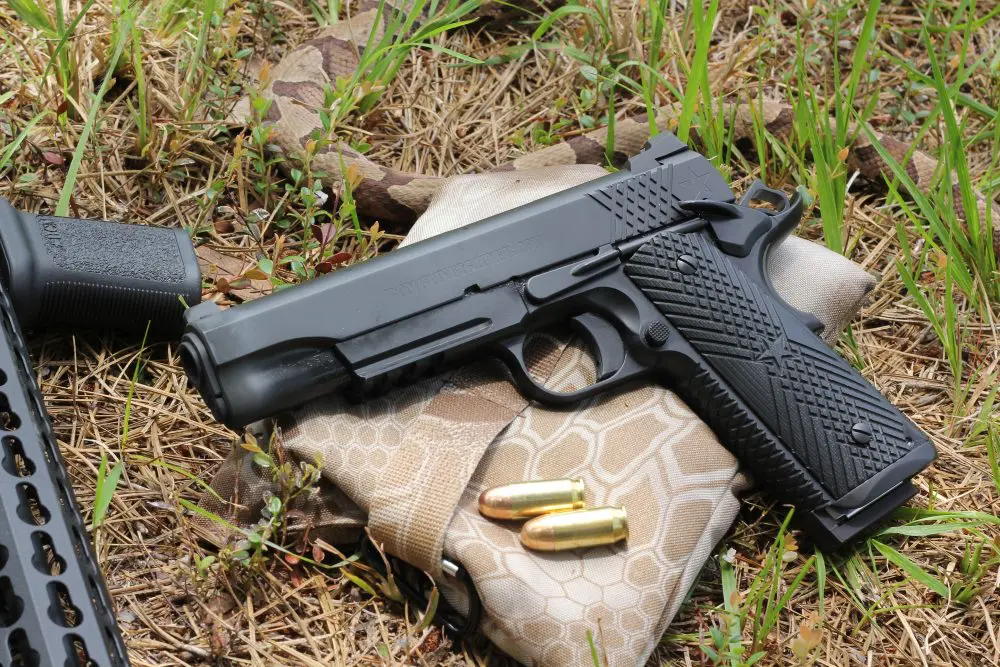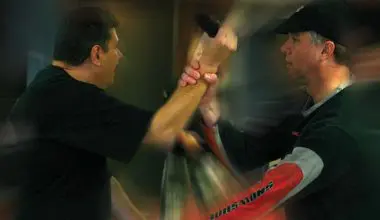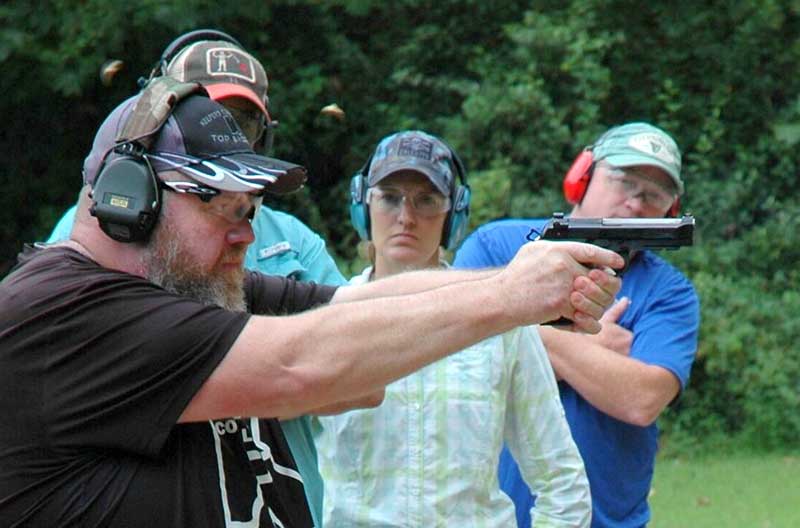
It’s been a long time since I was a student in a firearms class. My mavens were from the old school: Military, FBI, Cooper, Chapman, Shaw, Leatham, Rogers, Hackathorn, and Barnhart, although the latter five introduced changes that brought gun training to higher levels.
So I thought I was pretty well grounded in the art of defensive/offensive shooting and even wrote a book, RATTENKRIEG: The Art and Science of Close Quarter Pistol. But as new and contemporary instructors emerged from the military, law enforcement, and civilian communities, the art began to advance again, with many techniques that made sense and others that occasionally shocked me. Names like Green (deceased), Langdon, Keepers, McNamara, Vickers, Ellifritz, Seeklander, Roberts, and Givens, to name just a few, represent the new breed of firearms and tactics practitioners who are making sure the art of self-defense continues to evolve.
Table of Contents
RULE TWO VIOLATED
Being an old timer where safety, safety, and safety was habitually pounded into my head as a marine and FBI agent, I was disturbed by the increasing popularity of appendix inside-the-waistband carry (AIWB) because it violates Rule Two, which emphatically states, “Never let the gun’s muzzle cover or sweep something you are not willing to destroy.”
From what I could discern, AIWB orients the muzzle toward the groin, genitals, thigh, and femoral artery. Even with a “miss,” the surrounding area will be ripped and cauterized by muzzle blast. The danger of self-inflicted wounding is aggravated by incorrect holstering.
Of course, shooters of every skill level have had their share of negligent discharges while holstering strong side, but the path of most wounds of that nature usually travel through the hip or buttocks, down the outside of the leg and often exiting at the knee or lower leg.
If no bone is shattered or major blood vessels compromised and the bullet exits, band aids and an antibiotic may be the only treatment needed. The worst injuries incurred are embarrassment and a wounded ego.
NOT NEW

Nevertheless, after conducting some research, the speed and concealment advantages of AIWB became obvious. Also historically it was a preferred method of carry by many revolver-toting troopers and criminals of yesteryear. Criminals avoided holsters so they could ditch a handgun and not be linked to it by its holster if arrested.
I pride myself on having an open mind and am willing to take a look at a technique or tactic that on its face I don’t quite agree with. Knowledgeable friends in the gun community recommended I go to the AIWB guru, Spencer Keepers of Keepers Concealment, who is noted for his training and unique AIWB holsters. He also specializes in fitting AIWB rigs for people who have developed that middle age stomach roll … that really piqued my interest.
KEEPERS CONCEALMENT TRIAD
Fortunately, Keepers was scheduled to teach weekend awareness/avoidance and shooting schools or the “Keepers Concealment Triad” in the next county at a rural range facility, so I packed my gear and headed west.
Friday consisted of classroom instruction based on Southnarc material and included awareness, situational control, how to avoid a confrontation, proper verbalization to prevent escalation, recognizing pre-assault cues, how to break contact effectively, vehicle and parking lot security, child management, and even how to manage your firearm in a bathroom stall.
In one role-playing scenario, armed students carrying several packages depart their house on the way to work only to discover a stranger rummaging through their car. Most of the men who were physically imposing and competent gunmen chose armed confrontation, risking a shooting instead of what one woman did: dropped her packages, returned to the house, locked the door, and called police.
Keepers advised never to risk your life for something of material value. The goal for concealed carriers should be to never have to use it. Let it remain a last-resort option.
OKLAHOMA GUNFIGHTER
Spencer is a big, rugged-looking man who by his exceptional skills and honorable intent is by default one of a long line of famous Oklahoma gunfighters, which includes the FBI’s own Delf “Jelly” Bryce.
Carrying concealed for 31 years, he is deceptive and appears to the unpracticed eye to belong more on a farm or ranch than in front of a class of city slickers. He is articulate, poised, thorough, and humble in his presentations, but above all he is lethal with his gun and knife skills.
Training people to be self-sufficient in personal security is his passion. He appears to be almost on a mission to realize this goal. He teaches skills that have worked for ordinary people who found themselves in extraordinary situations. Unless you are an utter moron, you will leave Keepers’ class a better and more tactically sound shooter.
AIWB HOLSTERS, BELTS, CLOTHING, AND GUNS
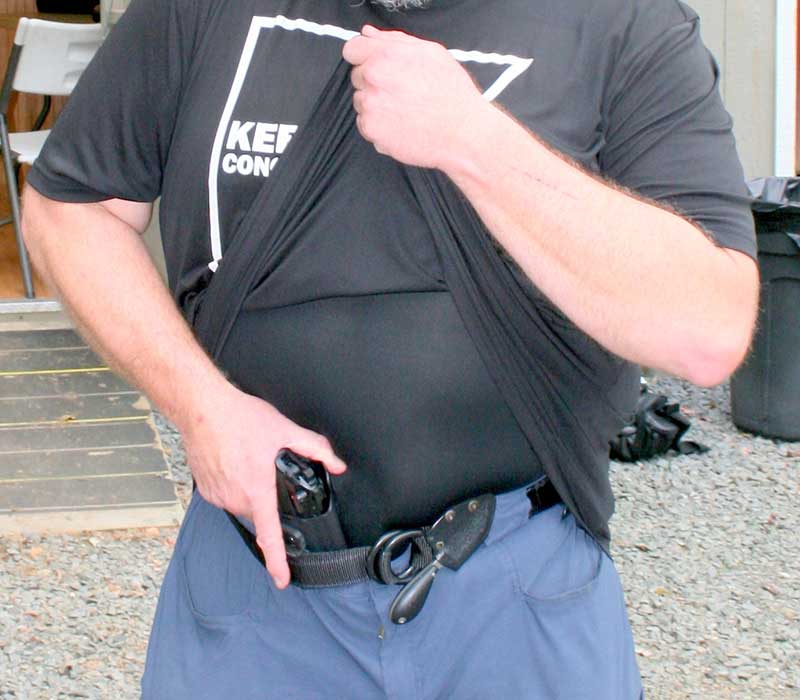
AIWB range day started with class introductions, a safety brief for running a hot range, and a review of many of the AIWB holsters on the market.
In about 2009, Keepers started making AIWB holsters out of necessity. He pointed out that good AIWB holsters should be rigid, including the sweat shield, so they don’t collapse and make holstering difficult and potentially dangerous. Cant, tension, and ride height should be adjustable, and it should be designed to hold the gun’s butt against the body.
Paunchy persons who dismiss AIWB carry because the weapon’s butt pokes out at an angle and prints should consider holsters with some form of cantilever and foam wedges that can be added or removed, which will push the barrel away from the body and the butt into the body.
Keepers is a portly individual but effectively hides a full-sized Langdon Tactical Technologies Elite Beretta 92 or Beretta PX4 Compact Carry if he employs his Errand or Keeper with a clip holster for an impromptu and brief trip from his residence after removing his primary carry rig.
This holster works with beltless sweatpants and is ideal for quick trips to convenience stores. Keepers added that in order of importance, you should select a holster and belt before you purchase the handgun. If you are not comfortable with the rig, you will not carry your blaster.
He prefers higher-waist trousers and a semi-rigid nylon climbing belt, worn for many eons by SWAT team members. Crazy strong and lightweight, it cinches the holster in tight against the body and supports magazine pouches, edged weapons, flashlights, etc.
For an undergarment, the Under Armour Compression Sleeveless Shirt wicks away moisture and has a smooth, non-drag surface. The cover garment should be a closed shirt to work properly, and dark is best for concealment or a vest if you have to dress more formally. The vest now becomes the cover garment.
AIWB ADVANTAGES

Keepers pointed out that AIWB supported a faster drawstroke based on economy of motion, better concealment and retention, comfort and ease of draw while seated. Also when seat belts are involved and properly adjusted, it gives easier support-hand access and longer-barreled models can be readily accommodated.
He demonstrated with a laser-equipped dummy gun that AIWB carry, if done properly, is “Safer than strong-side draw as you see the holster when reholstering.” Still skeptical and with my “The Keeper” holster secured but pointing down between my right thigh and crotch, I mused that if I am fortunate enough to miss my body, the round’s muzzle blast will make BBQ of my package.
However, Keepers pointed out that any wound is serious, because bullets do strange things when entering the body.
LINE ARSENAL
Glocks in one form or another dominated the range, with one outlier punching paper with a custom .45 ACP 1911. SIG Sauer P320s were popular, and the line arsenal was rounded out by a CZ Shadow 2, a Beretta 92F, and a little lady who admirably held her own armed with an S&W .380 Shield with grip safety. I was the only one deploying a grip safety equipped Springfield Armory XD Service pistol in 9x19mm.
Discussing the “safest” handguns for AIWB, Keepers prefers a double/single-action pistol with improved triggers and sights or a 1911-style piece with grip and thumb safeties.
Iron sights prevailed, but a couple of Glocks had RMRs mounted. Their operators did quite well at close-combat distances. But regardless of gun design, there should be no drama if the AIWB manual of arms is adhered to.
PRESENTATION FOCUS AND MANUAL OF ARMS
A good deal of time was spent dry while practicing the drawstroke and holstering. With hands at sides or in the surrender position, the draw sequence starts by grabbing the garment’s hem with the support hand, then bending the elbow and verifying that the pistol is higher than the cover garment (so it’s easier for the hands to meet), and establishing a two-handed grip.
Almost simultaneously, the gun hand acquires a full firing grip on the gun either by placing the thumb behind the holster and gun or touching the hammer or recoil plate with that digit.
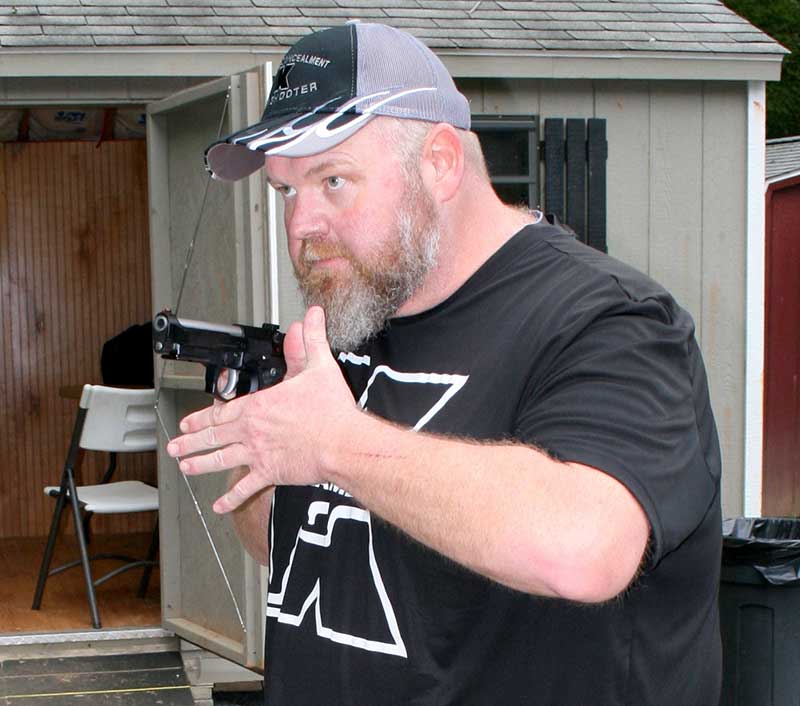
The pistol is brought into a high ready and the support hand performs a reverse “judo chop” under the trigger guard to establish a strong two-handed grip. The grip is critical for Keepers. It should be as high as possible and then some. He describes it as an X grip. Grip pressure is exerted to the point of hand shake and then backing off. Literally, he tries to push his fingers through the grip and touch the opposing hand. When focusing on that one element, my rapid-fire groups tightened up, allowing me to shoot faster with accuracy.
From the high ready, the gun is pushed out like a two-handed punch directly to the target. Trigger prep occurs during the extension, and ideally the shot breaks at the end of extension. Keepers teaches trigger reset by maintaining constant contact with the trigger.
Recovering, the pistol is brought back to the ready, turned inboard 90 degrees by the gun hand, and brought back straight to the holster along the target line. With the holster exposed and the body arched rearward with the trigger finger in register, the pistol is locked into the holster in a controlled manner.
A rearward body arch points the pistol away from the body when holstering.
On the range, the firearm remains in the holster when off the line. Ammo and magazines can be handled at any time, and magazine changes can be performed with the gun in the holster, taking extra care to ensure the magazine is seated.
As far as holster position is concerned, Keepers states, “It should be where your hand wants it to be.” Trigger-finger register is emphasized when off target, and Keepers reminded us that proper finger register starts in the holster.
GREAT DRILLS
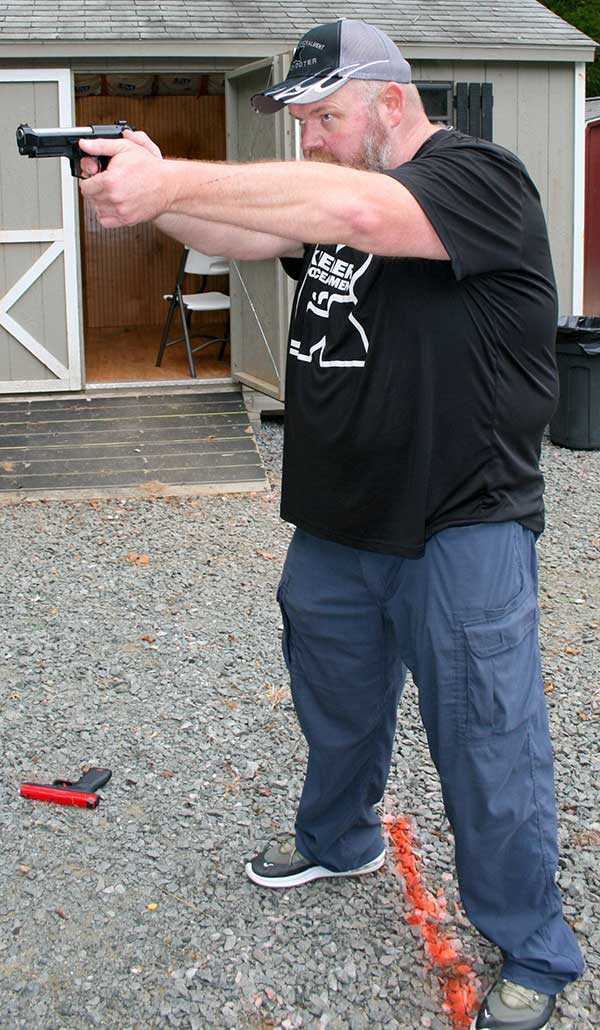
Various dot and center-mass drills were performed at close and intermediate ranges using Todd Green’s legacy target. My favorite drill among the many shot during the course was the extremely close-range, warp-speed multiple-target engagement exercise.
From 1.5 yards, Ernest Langdon’s Nine Round Speed Drill involves three targets situated abreast of each other. On the beep, draw and fire one round at T1 and T2 and two rounds at T3. Immediately reverse direction and fire one round at T2 and T1. Without hesitation, fire one round at the head of each target. Par time is 3.50 seconds.
I got into my bubble and the gun seemed to run itself. I had a decent time (3.90) but shot too soon on the last target, and the round was just short of the head. Keepers has shot this drill in 2.66 seconds and opines that, “You don’t know how to do it until you know how to execute it at speed.”
BASIC SKILLS

Solo strong- and support-hand shooting and reloading, along with support-hand draws were covered. A few students had enough flexibility to execute a reverse or Cavalry Draw with their support hand, and they smoked us for the first shot on target.
Keepers does not blade for single-hand shooting but remains square to the target, flexes his elbow and tenses his shoulders for one-handed action. When shooting support hand, he employs his non-dominant eye and keeps the pistol straight up.
Although one must know how, Keepers does not emphasize reloading. After he and his training cohorts studied thousands of shooting videos, they counted four reloads that took an average time of 15 seconds and had no effect on the fight’s outcome. However, the gun remains high, the head up and the slide release vice slide sling shot is used to drop the slide on a fresh round. Keepers doesn’t care how you do it as long as you get it done.
PLEASE COMPETE

Keepers advocates competition for the stress it creates and other benefits. AIWB is permitted in USPSA Open and Limited in ten divisions. It is not sanctioned for IDPA events. Keepers commented further, “On the day of my first shooting, I want to shoot at the Grand Master level.”
INTENSE COURSE
This is Keepers’ signature course, and training was intense but well-paced. I would characterize it as Fast Fundamentals, and Keepers managed to load ten pounds into a five-pound bag and do it competently. Personally, I had a great time and learned a great deal. Spencer is now a friend and it was good to bust lots of caps with likeminded people.
Will I adopt AIWB? I need to work with the system more before I decide, and I still do pretty well with strong-side carry.
SOURCE
KEEPERS CONCEALMENT
http://keepersconcealment.com

